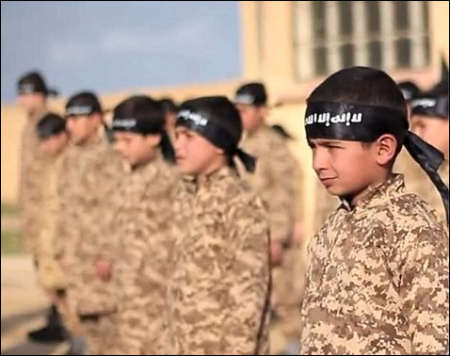INTELBRIEF
November 9, 2018
IntelBrief: Children of the Caliphate: Uncertain Futures and Living in Limbo

- Approximately 700 children were born in the caliphate to parents from Western countries, although many European governments are either unsure of what to do next or unwilling to let these children ‘return’ to their parents’ countries of origin.
- Some children witnessed killings, beheadings, and unspeakable atrocities, while others were active participants in murderous acts, including possible war crimes and crimes against humanity.
- Dealing with the ‘children of the caliphate’ is not simple—many of these children are both victims and perpetrators, a fact which cannot and should not be ignored.
- The physical territory of the caliphate is gone, but its core ideology has already been implanted in countless young and impressionable children. Countries need to craft a comprehensive strategy for dealing with those children who will return to their parents’ countries of origin.
.
Even though the fight against the so-called Islamic State continues in isolated corners of Iraq and Syria, the group now holds less than 1 percent of the land it had at its peak a few years ago. Fighters remain in pockets of territory in areas around Anbar, Kirkuk, and Salahuddin in Iraq and Hajin and other small Syrian villages dotting the Euphrates River Valley, but for the most part outright conflict has subsided considerably. What remains, however, is a lingering question of what to do with the most vulnerable among the Islamic State’s offspring—literally, the children born to Islamic State fighters and mothers while living in the caliphate, but who were or are citizens of neither Iraq nor Syria. Data suggests approximately 700 children were born in the caliphate to international parents. These children are now living in limbo, unrecognized as citizens of any particular country, unwanted by their captors and unable to return to the mostly Western countries where their parents were born before they traveled to Iraq and Syria.
Not all children were born in the ‘caliphate’; many accompanied their parents from Europe and elsewhere to Iraq and Syria. While some children witnessed killings, beheadings and other atrocities, others were active participants in murderous acts, including possible war crimes and crimes against humanity. Reports from the United Kingdom suggest that children as young as two years old were likely exposed to IS indoctrination and have demonstrated an obsession with violence and beheadings. The key for Western governments is to find a way to reintegrate and rehabilitate those children that have already or will return. It will be important to allow even those children who have experienced serious trauma to maintain a semblance of normalcy, while helping them to avoid being recruited by terrorist groups both online and physically present in neighborhoods that have been classified as radicalization hubs or breeding grounds for extremism.
There is a growing body of evidence documenting atrocities committed by children associated with IS. In one instance, a 13-year-old British citizen executed a Kurdish prisoner. In another, a seven-year old boy appears in a video holding a severed head. Even though these are isolated incidents, they have been sensationalized in the media and caused alarm among the European public. In Germany, the media has spoken of ‘kindergarten jihadists.’ The Islamic State ran schools for children, where textbooks indoctrinated students by highlighting specific themes considered most important by IS leadership: encouraging violence, driving an apocalyptic narrative, establishing a purist ‘Islamic’ state, and labeling it a caliphate. The last part is especially crucial for the future of IS, as young children were brainwashed with the notion that what IS had achieved—and indeed what these children, their families, and neighbors helped to build and were an integral part of—was a success of historic proportions.
IS pursued a deliberate and calculated strategy of targeting children and young teens, especially males, in order to construct parallel power structures, spread its ideology to young recruits, and sow the seeds for the next generation of future terrorists through its ‘cubs of the caliphate’ program. Yet dealing with the children of IS is not as straightforward as it might seem. In many cases, these kids are both victims and perpetrators, a fact which cannot and should not be ignored. The physical territory of the caliphate is gone, but its core messages, ideas, and narrative have already been implanted in countless numbers of children. Only by working to ensure that the current generation is not vulnerable to the allure of violent ideologies can countries avoid similar tragedies in the future. This effort will not be easy and will require a serious allocation of resources and political capital, something that many countries appear to be unwilling to do, which may prove myopic over time.
.
For tailored research and analysis, please contact: info@thesoufancenter.org
[video width="960" height="540" mp4="https://thesoufancenter.org/wp-content/uploads/2018/11/IB-1109.mp4" poster="https://thesoufancenter.org/wp-content/uploads/2018/11/Boys-as-young-as-eight-are-forced-by-Islamic-State-into-training-photo-is-video.jpg"][/video]